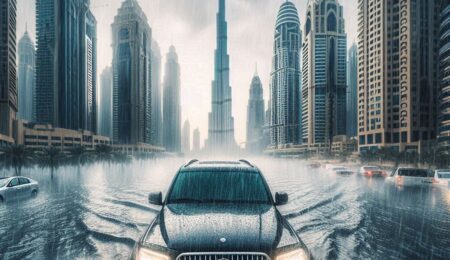How to Spot a Flood-Damaged Car in the UAE
As torrential rains struck the UAE on April 16, thousands of vehicles suffered flood damage, particularly those parked in low-lying areas and basements. Cities like Dubai, Sharjah, Ajman, and Umm Al Quwain saw unprecedented levels of water accumulation, impacting not only personal vehicles but also numerous car dealerships that traditionally store inventory in underground facilities. With such a high volume of vehicles affected, the used car market is now potentially flooded with cars that have sustained water damage. As a result, if you’re considering buying a used car in the aftermath of these storms, it is crucial to be vigilant and ensure that the vehicle you are purchasing has not been compromised by flood waters. Ensuring the car is free from water damage can save you from future mechanical and health issues associated with flood-damaged vehicles.

Spotting a flooded car in the UAE.
1. Check the Vehicle History
Before you consider purchasing, always check the vehicle’s history. Use reliable services to obtain a detailed report on the car. These reports can reveal if the vehicle has been involved in any major incidents, including flooding. Remember, honesty in seller disclosures can vary, and some histories might be masked.
2. Inspect for Rust and Corrosion
Floodwater causes metal to rust and corrode unusually quickly. Inspect areas that typically would not be exposed to water during normal use. This includes:
- Under the car: Check the axles and other metal parts for rust.
- Under the hood: Look for rust or corrosion on screws, bolts, and other components.
- Inside the car: Examine under seats and around the door frames for any signs of rust.
3. Look for Water Stains and Residue
Water leaves a tale-telling mark. Check for:
- Stains on upholstery, seat belts, and door panels.
- Sediment or mud in areas like glove compartments, under the dashboard, or within the spare tire compartment.
- Water lines on the car’s exterior and interior, which can show how high the water rose.
4. Evaluate the Electrical System
Flood damage severely impacts a car’s electrical system. Test all electrical components including:
- Lights, indicators, air conditioning system, infotainment system.
- Power windows and locks.
- Dashboard gauges and lights.
Inconsistencies or malfunctions in these systems could suggest prior water damage.

5. Smell for Mold and Mildew
A musty or moldy smell inside the car is a strong indicator of water exposure. Thoroughly smell the upholstery, especially in less ventilated areas like the trunk and under the seats. Sometimes, even after a thorough cleaning, the scent of mold and mildew can linger.
6. Examine the Oil and Fluids
Floodwater mixing with the fluids in a car can create noticeable changes. Check the oil and transmission fluid:
- If the oil has a milky residue, it may have been contaminated with water.
- Transmission fluid that is not clear or has a burnt smell may also indicate problems.
7. Hire a Professional Inspector
If you have any doubts, it’s advisable to hire a professional mechanic to inspect the car. They can perform a detailed check that might reveal hidden damage. This can save you significant expense and hassle in the future.
Get Flood Damage Reports in UAE
In UAE you can check a car’s history using its Vehicle Identification Number (VIN) through two main methods:
Free Options:
- Ministry of Interior (MoI) Website: Access this service by registering an account on the MoI website and entering the Chassis Number VIN. It provides accident history reported to authorities.
- Emirates Vehicle Gate (EVG): Requires a VIN and an EVG account to access accident history, similar to the MoI website.

But These services primarily focus on accidents reported to the authorities. They might not reveal other aspects of the car’s history, such as maintenance records, flood damage, or ownership changes.
Paid Flood Vehicles Report
Third-Party VIN Check Services:
Several companies offer paid VIN check reports in the UAE. These reports can be more comprehensive, including information on:
- Accident history (including unreported incidents)
- Maintenance records
- Mileage verification
- Flood damage reports
- Number of previous owners

Flood vehicles Inspection charges UAE
| Inspection Service | Description | Charges (AED) |
|---|---|---|
| Comprehensive Visual Inspection | Inspection of the interior for mould and mildew growth, which can indicate previous exposure to floodwaters. | 200 – 400 |
| Mechanical Inspection | Detailed examination of the engine, transmission, brakes, and other mechanical components for water damage and corrosion. | 300 – 600 |
| Electrical System Check | Testing of the car’s electrical systems, including lights, indicators, air conditioning, and infotainment, to identify any water-related issues. | 150 – 300 |
| Fluid Analysis | Analysis of oil, transmission fluid, and other fluids for signs of contamination by water or sediment. | 100 – 200 |
| Mold and Mildew Inspection | A comprehensive inspection is conducted by a certified mechanic, covering all aspects of the vehicle for flood damage and other issues. | 100 – 200 |
| Professional Mechanic Inspection | A comprehensive inspection conducted by a certified mechanic, covering all aspects of the vehicle for flood damage and other issues. | 500 – 1000 |
Please note that these charges are approximate and may vary depending on the service provider, the type and size of the vehicle, and the extent of the inspection required.
You Might like to read
How to Scrap a Car in Abu Dhabi: A Step-by-Step Guide
Flooded Car in Dubai? Here’s What To Do
The Top Fuel-Efficient 7-Seater SUVs in UAE for Families
Risks in Buying a Flooded Car

- Mechanical Issues: Water, especially saltwater, can severely damage a car’s mechanical components such as the engine, transmission, and braking system. These parts may function initially but could fail unexpectedly over time.
- Electrical Problems: Water can wreak havoc on a car’s electrical system, which includes the wiring and computer systems. This can lead to erratic behavior and failure of components like airbags, windows, lights, and more.
- Corrosion: Floodwater accelerates rust and corrosion on a car’s metal parts. This deterioration can weaken the car’s structural integrity and lead to long-term problems, often hidden deep within the car.
- Mold and Mildew: The interior of a flood-damaged car can develop mold and mildew, which are difficult to completely eradicate. Besides producing a bad smell, these fungi can cause allergic reactions and other health issues for passengers.
- Decreased Vehicle Value and Lifespan: A flood-damaged car generally has a much lower resale value and is likely to have a shorter operational lifespan. Even after repairs, the history of flood damage can affect the car’s marketability.
- Insurance and Warranty Issues: Many warranties will not cover flood damage, and insurance companies might offer limited coverage for such cars. This can leave the owner facing significant out-of-pocket expenses for repairs and maintenance.
Frequently Asked Questions
- How can I tell if a car has been flooded?
- Look for signs of water damage such as water stains, rust, or a musty odor in the interior.
- What are the risks of buying a flooded car?
- Flood damage can lead to mechanical issues, electrical problems, corrosion, and mold growth, impacting the car’s safety and longevity.
- Can flood damage be repaired?
- Some flood damage can be repaired, but it may be costly and not always effective in restoring the car to its original condition.
- Should I consider buying a flood-damaged car if it’s significantly cheaper?
- While it may seem like a good deal upfront, the long-term risks and expenses associated with flood damage often outweigh the initial savings.
- Are there any legal requirements for selling a flood-damaged car?
- Sellers are generally required to disclose flood damage to potential buyers to avoid legal repercussions.
- How can I check if a car has flood damage before buying?
- Conduct a thorough inspection for signs of water damage, and consider obtaining a vehicle history report to uncover any past flood incidents.
- What should I do if I suspect a car I’m interested in buying has flood damage?
- Walk away from the purchase and consider seeking a professional inspection to confirm your suspicions.
- Are there specific areas of the car I should pay close attention to during inspection?
- Check under the hood, in the trunk, and under carpets for signs of water intrusion, rust, and corrosion.
- Can flood damage affect a car’s electronics?
- Yes, floodwaters can damage a car’s electrical system, leading to malfunctions in various components such as lights, airbags, and infotainment systems.
- Is it possible for a flooded car to have a clean title?
- Yes, it is possible for a flooded car to have a clean title if the damage was not reported to the insurance company or if the car was not deemed a total loss. This underscores the importance of conducting thorough inspections before purchasing a used vehicle.






Leave feedback about this
You must be logged in to post a review.